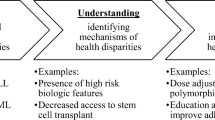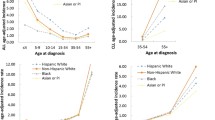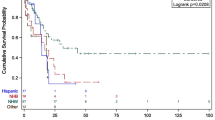Abstract
Purpose
Disparities in solid tumors have been well studied. However, disparities in hematologic malignancies have been relatively unexplored on population-based levels. The purpose of this study is to examine the relationship between race/ethnicity and acute leukemia mortality.
Methods
All patients with acute leukemia [acute lymphoblastic leukemia (ALL) and acute myelogenous leukemia (AML)] were identified in the Surveillance Epidemiology and End Results database, 1999–2008. Kaplan–Meier curves were generated to reflect survival probabilities by race/ethnicity. Multivariable Cox proportional hazard models estimated hazard of mortality by race with adjustment for individual (age, gender, year of diagnosis) and select genetic factors.
Results
A total of 39,002 patients with acute leukemia were included in the study. Overall, there was a mortality disparity in acute leukemia for blacks (HR 1.17, p < 0.0001) and Hispanics (HR 1.13, p < 0.0001) compared with non-Hispanic whites. In stratified analysis, disparities in ALL were greater than AML; blacks (HR[ALL]1.45, p < 0.0001; HR[AML]1.12, p < 0.0011); Hispanics (HR[ALL]1.46, p < 0.0001; HR[AML]1.06, p < 0.0001). Adjustment for individual patient and select genetic factors did not explain disparities.
Conclusions
Blacks and Hispanics suffer decreased survival in acute leukemia as compared to others. Further investigation is needed to understand the drivers of poor cancer outcomes in these populations.



Similar content being viewed by others
Explore related subjects
Discover the latest articles and news from researchers in related subjects, suggested using machine learning.References
The American Cancer Society www.acs.org. Accessed 18 Nov 2011
The President’s Cancer Panel www.deainfo.nci.nih.gov. Accessed 18 Nov 2011
White A, Vernon SW, Franzini L et al (2011) Racial disparities in colorectal cancer survival: to what extent are racial disparities explained by differences in treatment, tumor characteristics, or hospital characteristics? Cancer 116:4622–4631
Vainshtein J (2008) Disparities in breast cancer incidence across racial/ethnic strata and socioeconomic status: a systematic review. J Natl Med Assoc 100:833–839
Underwood JM, Townsend JS, Tai E et al. (2011).Racial and regional disparities in lung cancer incidence. Cancer
Rubnitz JE, Lensing S, Razzouk BI et al (2007) Effect of race on outcome of white and black children with acute myeloid leukemia: the St. Jude experience. Pediatr Blood Cancer 48:10–15
Kadan-Lottick NS, Ness KK, Bhatia S et al (2003) Survival variability by race and ethnicity in childhood acute lymphoblastic leukemia. JAMA 290:2008–2014
Foucar K, Duncan MH, Stidley CA et al (1991) Survival of children and adolescents with acute lymphoid leukemia. A study of American Indians and Hispanic and non-Hispanic whites treated in New Mexico (1969 to 1986). Cancer 67:2125–2130
Bhatia S, Sather HN, Heerema NA et al (2002) Racial and ethnic differences in survival of children with acute lymphoblastic leukemia. Blood 100:1957–1964
Kent EE, Sender LS, Largent JA et al (2009) Leukemia survival in children, adolescents, and young adults: influence of socioeconomic status and other demographic factors. Cancer Causes Control 20:1409–1420
Aplenc R, Alonzo TA, Gerbing RB et al (2006) Ethnicity and survival in childhood acute myeloid leukemia: a report from the Children’s Oncology Group. Blood 108:74–80
Goggins WB, Lo FF (2012) Racial and ethnic disparities in survival of US children with acute lymphoblastic leukemia: evidence from the SEER database: 1988–2008. Cancer Causes Control 23:737–743
Pullarkat ST, Danley K, Bernstein L et al (2009) High lifetime incidence of adult acute lymphoblastic leukemia among Hispanics in California. Cancer Epidemiol Biomarkers Prev 18:611–615
Sekeres MA, Peterson B, Dodge RK et al (2004) Differences in prognostic factors and outcomes in African Americans and whites with acute myeloid leukemia. Blood 103:4036–4042
Rodriguez CP, Baz R, Jawde RA et al (2008) Impact of socioeconomic status and distance from treatment center on survival in patients receiving remission induction therapy for newly diagnosed acute myeloid leukemia. Leuk Res 32:413–420
Byrne MM, Halman LJ, Koniaris LG et al (2011) Effects of poverty and race on outcomes in acute myeloid leukemia. Am J Clin Oncol 34:297–304
Bradley CJ, Dahman B, Jin Y, et al. (2011) Acute myeloid leukemia: How the Uninsured Fare. Cancer
Brady AK, Fu AZ, Earl M et al (2011) Race and intensity of post-remission therapy in acute myeloid leukemia. Leuk Res 35:346–350
Pulte D, Gondos A, Brenner H (2008) Improvements in survival of adults diagnosed with acute myeloblastic leukemia in the early 21st century. Haematologica 93:594–600
Surveillance, Epidemiology, and End Results http://www.seer.gov. Accessed 11 Aug 2011
Shoenfield Residuals. Available at http://biomet.oxfordjournals.org/content/69/1/239.short. Accessed 27 July 2012
Gray GE, Henderson BE, Pike MC (1980) Changing ratio of breast cancer incidence rates with age of black females compared with white females in the United States. J Natl Cancer Inst 64:461–463
Wilkinson JD, Fleming LE, MacKinnon J et al (2001) Lymphoma and lymphoid leukemia incidence in Florida children: ethnic and racial distribution. Cancer 91:1402–1408
Zak Y, Rhoads KF, Visser BC (2011) Predictors of surgical intervention for hepatocellular carcinoma: race, socioeconomic status, and hospital type. Arch Surg 146:778–784
Rhoads KF, Cullen J, Ngo JV et al. (2011) Racial and ethnic differences in lymph node examination after colon cancer resection do not completely explain disparities in mortality. Cancer
Caligiuri MA, Stout MP, Gilliland DG (1997) Molecular biology of acute myeloid leukemia. Semin Oncol 24:32–44
National Cancer Institute http://www.cancer.org. Accessed 11 Aug 2011
Jaffe ES, Harris NL, Diebold J, Muller-Hermelink HK (1998) World Health Organization classification of lymphomas: a work in progress. Ann Oncol 9(Suppl 5):S25–S330
Acknowledgments
Our manuscript contains original data. There was full access to all the data in the study, and all authors take full responsibility for the integrity of the data and the accuracy of the data analysis. There are no conflicts of interest to disclose for any author listed in the manuscript.
Author information
Authors and Affiliations
Corresponding author
Rights and permissions
About this article
Cite this article
Patel, M.I., Ma, Y., Mitchell, B.S. et al. Understanding disparities in leukemia: a national study. Cancer Causes Control 23, 1831–1837 (2012). https://doi.org/10.1007/s10552-012-0062-3
Received:
Accepted:
Published:
Issue Date:
DOI: https://doi.org/10.1007/s10552-012-0062-3




